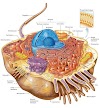Quorum sensing is a phenomenon in which bacteria can communicate with members of their own species and other species to coordinate their behavior. This phenomenon is achieved by the production and sensing of secreted signal molecules, which diffuse from the microbial cells and build up in the environment.
That allows for bacteria to coordinate responses to achieve many outcomes – including overwhelming the immune system, colonization of a host, and the production of toxins. Vibrio cholerae (V. cholerae) is a human pathogen that utilizes quorum sensing to colonize a host and produce its toxin.
Quorum Sensing in Vibrio cholerae
Quorum signaling is controlled by two opposing pathways: the CqsS/CqsA pathway (produces and detects CAI-1), and the LuxS/LuxPQ pathway (produces and detects AI-2). CAI-1 and AI-2 are autoinducers which regulate quorum sensing in V. cholerae.
At low cell densities (i.e. low concentration of autoinducers), V. cholerae expresses virulence genes that allow this bacterial species to colonize the small intestine. This is achieved by CqsS and LuxQ activating LuxU. Once LuxU is activated it phosphorylates LuxO, which then activates transcription of four regulatory sRNAs (Qrr1-4). Qrr1-4 activate the transcription of AphA and inhibit the transcription of HapR. In addition, AphA induces the transcription of virulence genes.
That allows for bacteria to coordinate responses to achieve many outcomes – including overwhelming the immune system, colonization of a host, and the production of toxins. Vibrio cholerae (V. cholerae) is a human pathogen that utilizes quorum sensing to colonize a host and produce its toxin.
Quorum Sensing in Vibrio cholerae
Quorum signaling is controlled by two opposing pathways: the CqsS/CqsA pathway (produces and detects CAI-1), and the LuxS/LuxPQ pathway (produces and detects AI-2). CAI-1 and AI-2 are autoinducers which regulate quorum sensing in V. cholerae.
At low cell densities (i.e. low concentration of autoinducers), V. cholerae expresses virulence genes that allow this bacterial species to colonize the small intestine. This is achieved by CqsS and LuxQ activating LuxU. Once LuxU is activated it phosphorylates LuxO, which then activates transcription of four regulatory sRNAs (Qrr1-4). Qrr1-4 activate the transcription of AphA and inhibit the transcription of HapR. In addition, AphA induces the transcription of virulence genes.








0 Comments